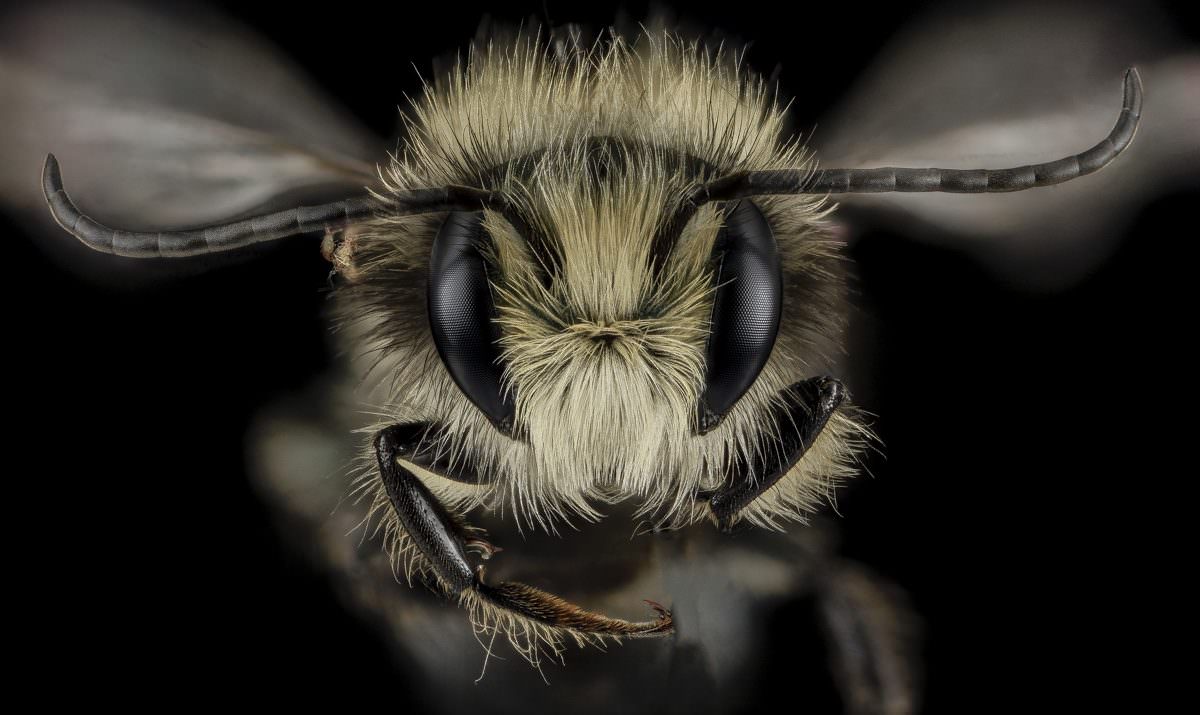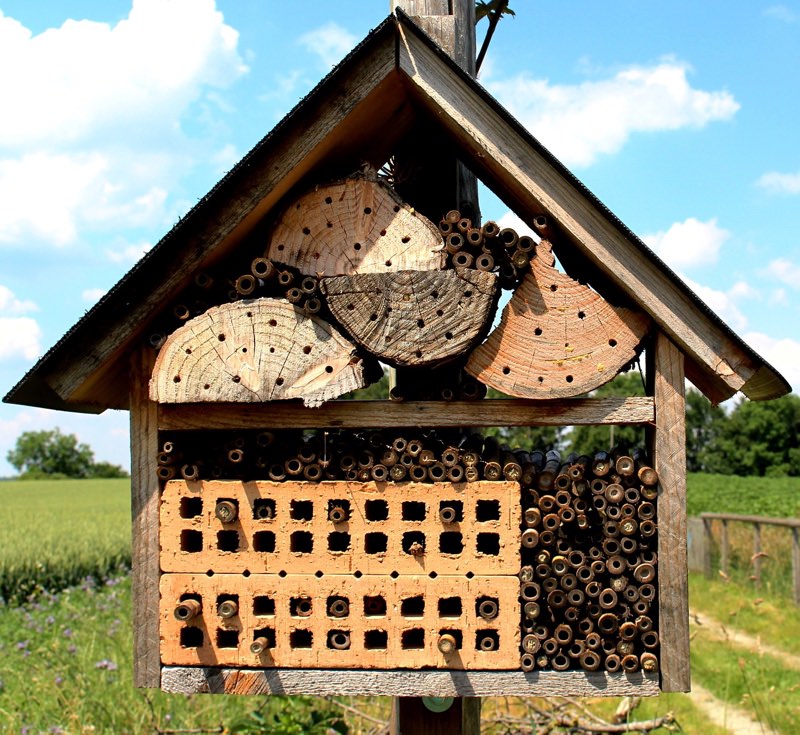Meet North America’s Native Pollinator: The Blue Orchard Bee
Your friendly, incorrigible local bee.
Meet North America’s Native Pollinator: The Blue Orchard Bee
Your friendly, incorrigible local bee.

All species of honey bees are Old World insects. They originated in Africa or Asia – we’re not totally sure – before being domesticated and spread to every continent besides Antarctica. The Europeans brought their preferred species of honey bee, the western (or European) honey bee, to the New World in 1622. This all begs the question: what the heck was pollinating the New World’s plants before then?
Well, North America is home to a whole bunch of very different bee species beyond the honey bee, including those sometimes referred to as mason bees or leafcutter bees. Perhaps the best known and most useful of these is the blue orchard bee, which is adorably referred to by the USDA and others as BOB. Haha. Hello, BOB!
Blue orchard bees are very, very different from honey bees. For one thing, they are, as their name suggests, a sort of blue-black in color, unlike the classic striped honey bee. But that’s just the beginning. Unlike honey bees, which form huge, complex hives, blue orchard bees are solitary creatures, though not particularly hostile to each other. Each spring, a female blue orchard bee finds a mate, and then goes on the hunt for a suitable nesting place. They like little holes, tubes or other small spots. Then the mother builds little partitions within the hole out of mud and fills them with pollen and nectar before laying one egg in each partition. Each mother will lay about five eggs. (Check out this tutorial on how to build a native bee hotel, pictured below, to learn more.)
Blue orchard bees might be efficient pollinators, but they’re terrible employees.
What makes blue orchard bees enticing to farmers, aside from the fact that they’re inherently cool and native to this country, is that they’re actually much more efficient pollinators than honey bees. This is partly as a result of their solitary nature and partly a result of the fact that they they collect pollen with their abdomens, rather than their their legs, which is what honey bees do; BOBs perform this goofy sort of swimming motion within the flower to get pollen to stick to them. This swimming motion is really great for spreading pollen from one plant to another, if not quite as great for actually collecting pollen to give to their broods.

So, you might be asking, why aren’t we going all-in on blue orchard bees as pollinators for fruit and almond trees? The primary reason is that it’s really hard to get them to actually stay in one place and do what farmers want. Blue orchard bees, unlike honey bees, won’t make a hive their home for generations on end; if you release a whole bunch of blue orchard bees near a nice custom-made nest, a good percentage of them will just…fly away. And then you’ll have to do the whole thing again next year. Blue orchard bees might be efficient pollinators, but they’re terrible employees.
A new study from the USDA’s Agricultural Research Service experimented with new ways to entice blue orchard bees to stick around and make our farms and orchards their home. At the moment, usual attempts to attract blue orchard bees consist of a big hive – which you can buy or make pretty easily – and a few smaller satellite hives placed nearby. The new study tried something different: a whole bunch of smaller hives scattered evenly throughout the area to be pollinated. The idea is to stop treating these bees like honey bees, and start working with their quirks and love of autonomy.
And the study seems to have worked! Researchers collected data on things like hive occupancy rates, number of larvae per hive, and number of larvae per individual mother bee, and each category saw an improvement.
Given that this was a single year study, it’s unclear whether this strategy will result in more second-generation blue orchard bees choosing to stay where they were born. But the researchers will be measuring again this summer, and with any luck, we might figure out a way to work with our local friend, BOB.
Follow us
This work is licensed under a Creative Commons Attribution-NoDerivatives 4.0 International License.
Want to republish a Modern Farmer story?
We are happy for Modern Farmer stories to be shared, and encourage you to republish our articles for your audience. When doing so, we ask that you follow these guidelines:
Please credit us and our writers
For the author byline, please use “Author Name, Modern Farmer.” At the top of our stories, if on the web, please include this text and link: “This story was originally published by Modern Farmer.”
Please make sure to include a link back to either our home page or the article URL.
At the bottom of the story, please include the following text:
“Modern Farmer is a nonprofit initiative dedicated to raising awareness and catalyzing action at the intersection of food, agriculture, and society. Read more at <link>Modern Farmer</link>.”
Use our widget
We’d like to be able to track our stories, so we ask that if you republish our content, you do so using our widget (located on the left hand side of the article). The HTML code has a built-in tracker that tells us the data and domain where the story was published, as well as view counts.
Check the image requirements
It’s your responsibility to confirm you're licensed to republish images in our articles. Some images, such as those from commercial providers, don't allow their images to be republished without permission or payment. Copyright terms are generally listed in the image caption and attribution. You are welcome to omit our images or substitute with your own. Charts and interactive graphics follow the same rules.
Don’t change too much. Or, ask us first.
Articles must be republished in their entirety. It’s okay to change references to time (“today” to “yesterday”) or location (“Iowa City, IA” to “here”). But please keep everything else the same.
If you feel strongly that a more material edit needs to be made, get in touch with us at [email protected]. We’re happy to discuss it with the original author, but we must have prior approval for changes before publication.
Special cases
Extracts. You may run the first few lines or paragraphs of the article and then say: “Read the full article at Modern Farmer” with a link back to the original article.
Quotes. You may quote authors provided you include a link back to the article URL.
Translations. These require writer approval. To inquire about translation of a Modern Farmer article, contact us at [email protected]
Signed consent / copyright release forms. These are not required, provided you are following these guidelines.
Print. Articles can be republished in print under these same rules, with the exception that you do not need to include the links.
Tag us
When sharing the story on social media, please tag us using the following: - Twitter (@ModFarm) - Facebook (@ModernFarmerMedia) - Instagram (@modfarm)
Use our content respectfully
Modern Farmer is a nonprofit and as such we share our content for free and in good faith in order to reach new audiences. Respectfully,
No selling ads against our stories. It’s okay to put our stories on pages with ads.
Don’t republish our material wholesale, or automatically; you need to select stories to be republished individually.
You have no rights to sell, license, syndicate, or otherwise represent yourself as the authorized owner of our material to any third parties. This means that you cannot actively publish or submit our work for syndication to third party platforms or apps like Apple News or Google News. We understand that publishers cannot fully control when certain third parties automatically summarize or crawl content from publishers’ own sites.
Keep in touch
We want to hear from you if you love Modern Farmer content, have a collaboration idea, or anything else to share. As a nonprofit outlet, we work in service of our community and are always open to comments, feedback, and ideas. Contact us at [email protected].by Dan Nosowitz, Modern Farmer
April 21, 2017
Modern Farmer Weekly
Solutions Hub
Innovations, ideas and inspiration. Actionable solutions for a resilient food system.
ExploreExplore other topics
Share With Us
We want to hear from Modern Farmer readers who have thoughtful commentary, actionable solutions, or helpful ideas to share.
SubmitNecessary cookies are absolutely essential for the website to function properly. This category only includes cookies that ensures basic functionalities and security features of the website. These cookies do not store any personal information.
Any cookies that may not be particularly necessary for the website to function and are used specifically to collect user personal data via analytics, ads, other embedded contents are termed as non-necessary cookies.
Im in love with this bee! I discovered my first today collecting necter from iron weed! Great read thanks for the info!